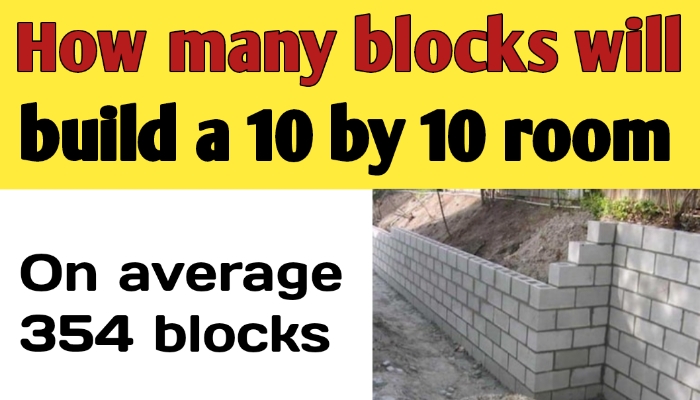If you think about a new project to start building a new room with concrete blocks, first think about the estimate and how many blocks are needed to build a 10 by 10 room. So first make a rough estimate because ordering too little block would lead to prolong your project and ordering too much is easy way to waste your money.

In this article we explain and make rough estimate based on calculation to figure out how many blocks will build a 10 x 10 room in easy steps that should be easy for calculating this for everyone. This prevent us loosing money, waste of time and reduced the cost of your project by deduction in labour and material cost and also decreases stress in mind.
The number of blocks will required to build a room depends on many factors like dimension of your room (length x width), height of the wall, size of using blocks, the size of window and door opening, skill of mason, pattern of laying blocks and waste factors during transportation, storage and installation.
There are many sizes of cinder blocks are available in market, but most common is 8 inches full CMU which has nominal size is 16 inches (400 mm) long, 8 inches (200 mm) in height and 8 inches (200 mm) in thickness (width). Actual size of block is 3/8″ or 10 mm is smaller than nominal size for mortar joints. So, actual size of 8″ full CMU is 15-5/8″ long, 7-5/8′ in height and 7-5/8″ in thickness.
The number of concrete blocks (8″ CMU) needed to build a 10 by 10 feet room depends on various factors, including: 1) The size of block (length, width, and height), 2) The thickness of wall (single course or double course), 3) The height of the wall, and 4) The design of the room (straight walls or corners).
How many blocks will build a 10 by 10 room
To figure out how many blocks are needed to build a 10×10 feet room, multiply the length of wall by 4 to find the total perimeter of the four walls of the room, then multiply perimeter to height of the wall to get total area of the walls. Now multiply the area by 1.125 blocks per square foot to get total blocks needed.
You should deduct the area of opening (window and door) and add the 10% as waste factor in which some blocks are get damage. If you assume: the standard cinder blocks that is 8″ x 8″ x 16″, single course and straight walls and walls height 8 feet each.
Here’s an estimate for blocks needed to build a 10×10 room:
1. Estimate perimeter of walls: Multiply length of wall by 4, such as perimeter = 10 ft x 4 (for all sides) = 40 linear feet
2. Estimate the surface area of walls: Multiply the perimeter by height of wall, such as area for walls = 40 feet x 8 ft = 320 square feet.
3. Estimate area of opening: Calculate the area of standard size window (3’x4′), door (3’x7′) and vent (1’x1′), such as total deduction area = 12 sq ft + 21 sq ft + 1 sq ft = 34 sq ft
4. Estimate the final walls area: Deduct the area of opening from four wall, such as final area which require block work = 320 _ 34 = 286 square feet
5. Estimate face area of one block: To calculate the face area of one block multiply length and height of block and then divide by 144 to get area in square feet, so face area of block = (16 x 8)/144 = 128/144 = 0.888 square feet
6. Estimate number of blocks per square foot: Divide the 1 square foot by face area of one block, such as blocks per square foot = 1/0.888 = 1.125 blocks
7. Estimate number of blocks: Multiply the final area of walls by 1.125 blocks per square foot, such as concrete blocks required = 286 x 1.125 = 322 blocks
8. Add 10% as waste factor: Calculate 10% as waste factor for corners and potential cuts, so 10% of 322 blocks that is approximately 32 blocks, so total number of blocks you needed = 322 + 32 = 354 blocks
On average, there area 354 concrete blocks are needed to build a 10 by 10 feet room with 8″ CMU (8″ x 8″ x 16″), single-layer and 8 feet high walls. However, their actual number will vary as per design practices and dimension of block you are using.
